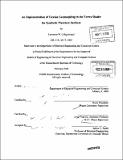| dc.contributor.advisor | Bryan Wasileski and Jovan Popović. | en_US |
| dc.contributor.author | Colagiovanni, Lawrence W. (Lawrence William) | en_US |
| dc.contributor.other | Massachusetts Institute of Technology. Dept. of Electrical Engineering and Computer Science. | en_US |
| dc.date.accessioned | 2009-06-30T16:56:29Z | |
| dc.date.available | 2009-06-30T16:56:29Z | |
| dc.date.copyright | 2008 | en_US |
| dc.date.issued | 2008 | en_US |
| dc.identifier.uri | http://hdl.handle.net/1721.1/45990 | |
| dc.description | Thesis (M. Eng.)--Massachusetts Institute of Technology, Dept. of Electrical Engineering and Computer Science, 2008. | en_US |
| dc.description | Includes bibliographical references (p. 55). | en_US |
| dc.description.abstract | The purpose of this research is to develop the three-dimensional models of planetary surfaces which can be used in the test environments for the Vision-Based Navigation Systems' (VBNS) terrain recognition and navigation algorithms. The VBNS will fly a trajectory over the planet, taking pictures along the flight and dynamically updating the imagery passed to the VBNS. The pictures will be generated based on the current camera angle and attitude. Testing in this more realistic, arbitrary planetary environment will help ensure the most robust algorithms for the VBNS. A terrain generation tool is implemented that allows users to create synthetic planetary terrains. Users are able to arbitrarily place terrain features (e.g. craters, mountains, and boulders), textures, and lighting to create realistic planetary surfaces. Creating these complex, three dimensional models presents its own problem: a significantly larger amount of data has to be processed. To solve this problem, geomorphing is implemented and incorporated into the simulations. Geomorphing refers to the process of seamlessly switching between different levels of-detail of data, which are data sets with different resolutions; the goal is to display the appropriate level-of-detail of data based on where the VBNS is currently located. Simply switching between the different data sets causes discontinuities and visual anomalies, which affect the algorithms of the VBNS. Therefore, the switching has to be done seamlessly, so that the VBNS cannot tell there was a change in the data sets being rendered. The test results indicate that geomorphing helped to reduce the discontinuities in the simulations that occur when simply switching between the different levels-of-detail. | en_US |
| dc.description.statementofresponsibility | by Lawrence W. Colagiovanni. | en_US |
| dc.format.extent | 55 p. | en_US |
| dc.language.iso | eng | en_US |
| dc.publisher | Massachusetts Institute of Technology | en_US |
| dc.rights | M.I.T. theses are protected by
copyright. They may be viewed from this source for any purpose, but
reproduction or distribution in any format is prohibited without written
permission. See provided URL for inquiries about permission. | en_US |
| dc.rights.uri | http://dspace.mit.edu/handle/1721.1/7582 | en_US |
| dc.subject | Electrical Engineering and Computer Science. | en_US |
| dc.title | An implementation of terrain geomorphing in the vertex shader for synthetic planetary surfaces | en_US |
| dc.type | Thesis | en_US |
| dc.description.degree | M.Eng. | en_US |
| dc.contributor.department | Massachusetts Institute of Technology. Department of Electrical Engineering and Computer Science | |
| dc.identifier.oclc | 351452410 | en_US |
